Solar Charging Station
About Solar
What is Solar Power?
Solar power is a renewable energy source that harnesses the energy of incoming sunlight and converts it into usable electricity using a solar panel or photovoltaic array.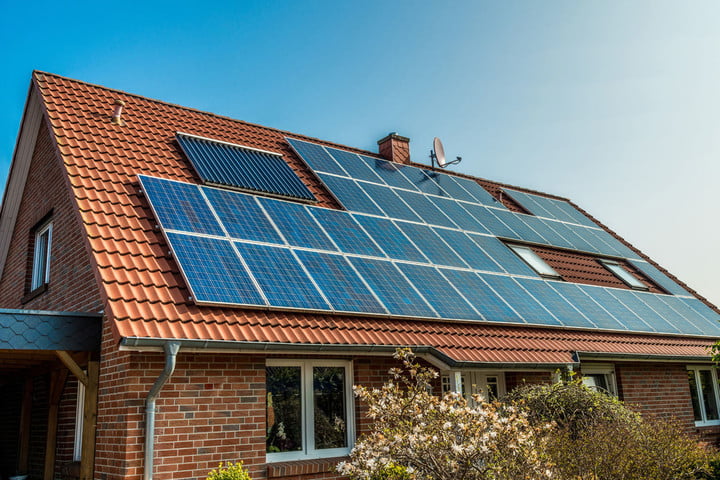
Source: https://cleantechnica.com/2014/09/04/solar-panel-cost-trends-10-charts/
Source: https://inhabitat.com/solar-panel-roof-tiles/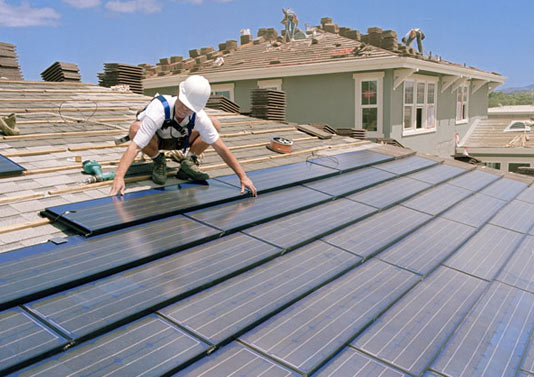

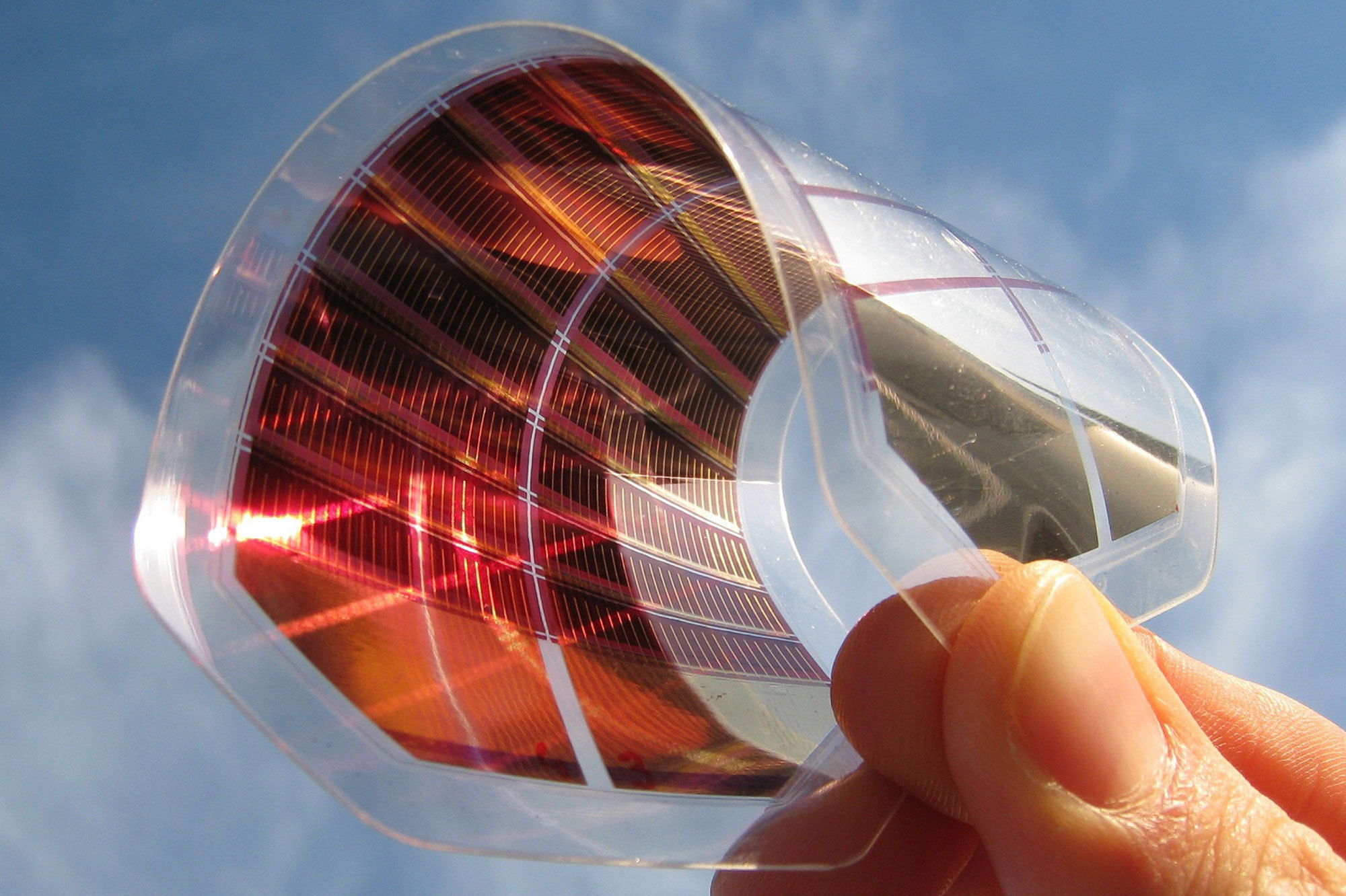
Sources: https://inhabitat.com/solar-panel-roof-tiles/ | https://discovere.binghamton.edu/features/coe-5885.html | http://scientifist.com/3-in-1-renewable-energy-material/perovskite-flexible-solar-cell/
When sunlight penetrates a solar cell it causes the atoms in the semiconductor layers to release electrons which are then collected using conductive electrodes. This creates a current and usable electricity for powering of electronics and storage in battery banks. The figure below shows a schematic of a solar cell’s layered structure. Solar cells create electron flow when a photon or packet of light is incident on the panels surface.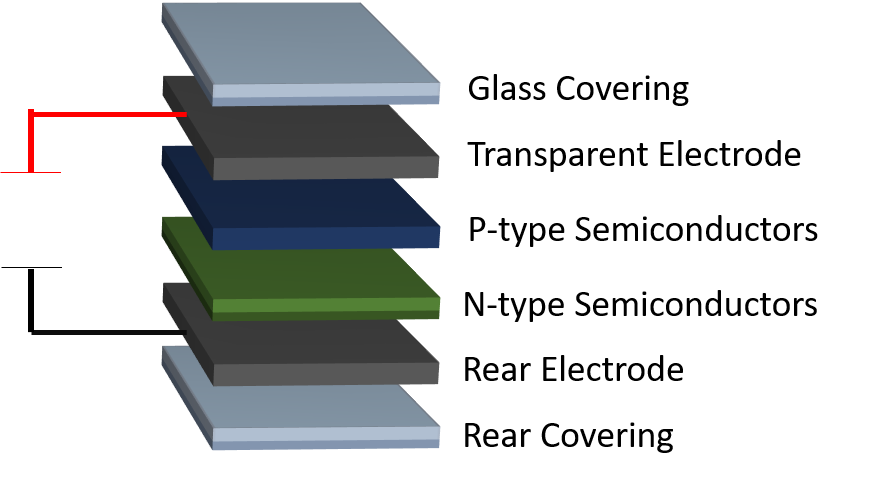
While solar power has a very promising future, low efficiency, high cost, and inability of commercial batteries to meet the needs of large-scale grid energy storage has limited its implementation into modern infrastructure. The current record for the highest efficiency solar cell to be released commercially released is 22.5%. The low efficiency of solar cells has been an issue that has plagued the research community for years. However, incremental success in improving the efficiencies over the year with the record for a non-commercialized cell currently at 44.5%. Additionally, lowering the cost of panels could outmode the need for higher efficiencies.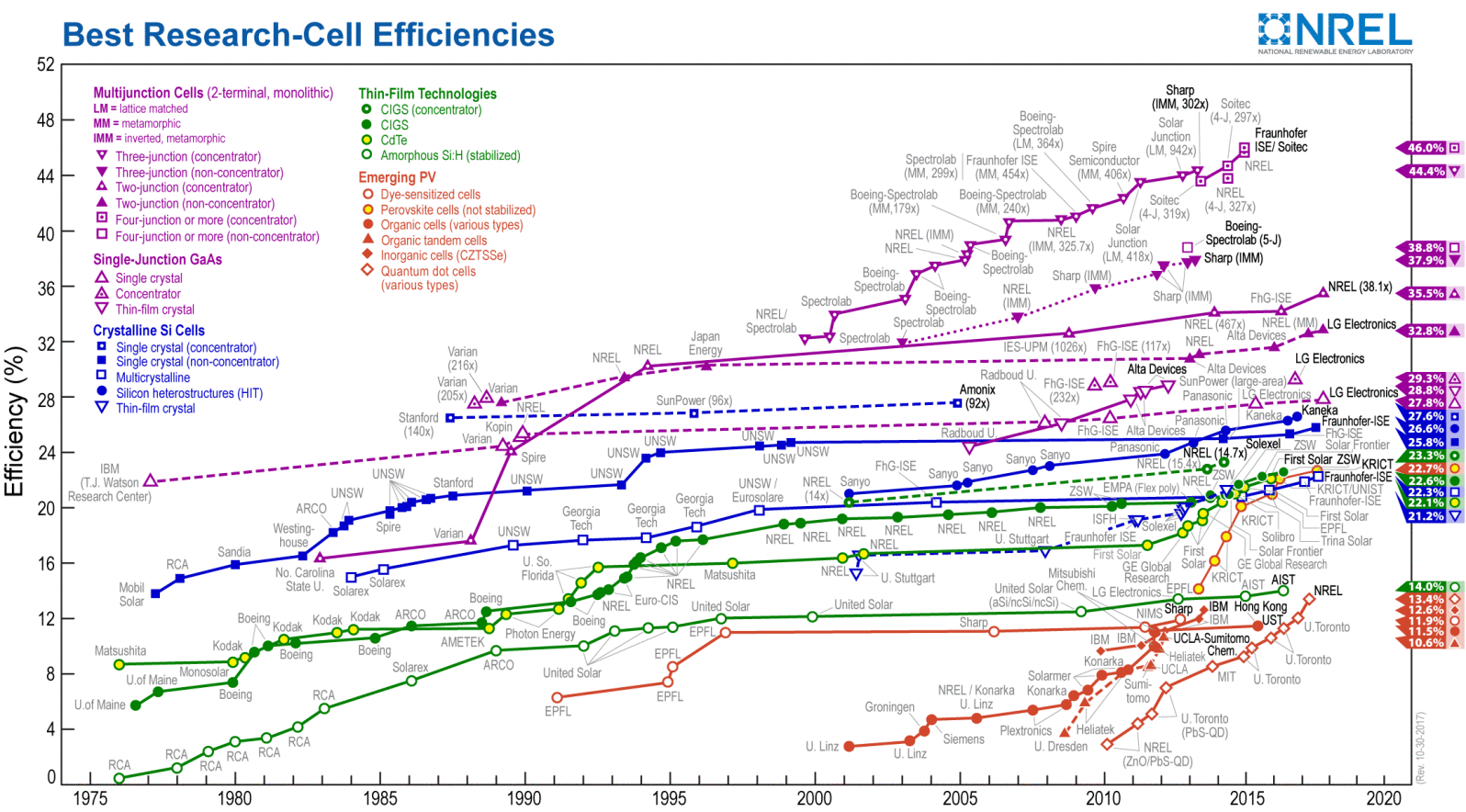
Source: https://electrek.co/2018/02/17/solar-panel-efficiency-bloodsport-records-trina-sunpower-hanergy-thin-film-monoperc/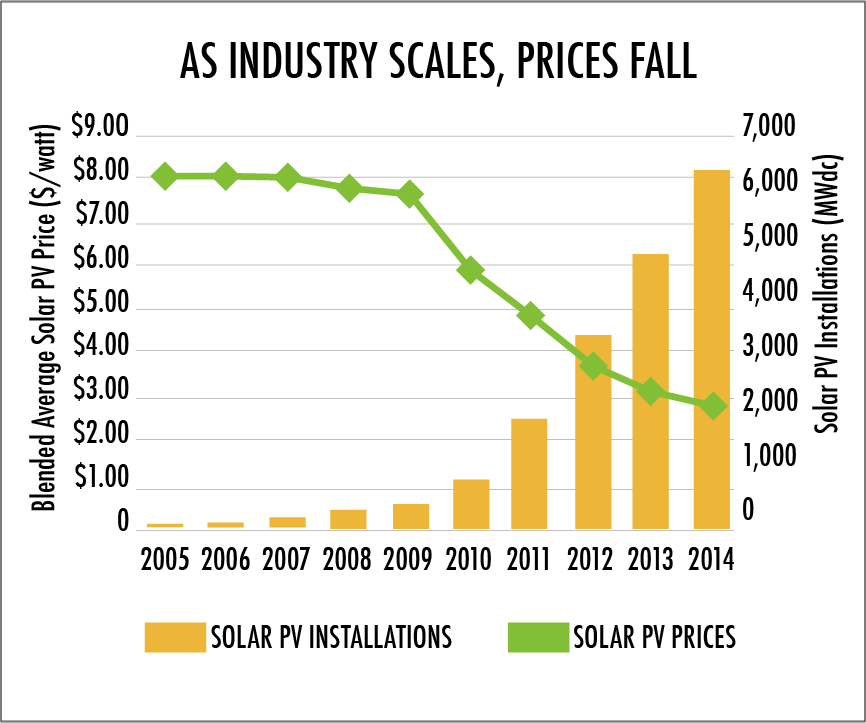
Source: https://solartribune.com/solar-panels-cost/
Source: http://www.smart2zero.com/news/submersible-solar-cell-promises-water-splitting-renewable-fuel-generation
There are a large number of issues facing the growing solar industry, but there is also a large field of dedicated scientists and engineers studying and designing new methods for improving efficiencies and lowering costs. The field of solar is fast paced and extremely expansive with researchers and design engineers all over the world attempting to solve the challenges holding back the development of low cost solar infrastructure. Solar research is at the intersection of dozens of related fields from bio-organic materials to mechanical engineering design. Below are just a few of the cutting-edge technologies being developed today.
Solar power is a renewable energy source that harnesses the energy of incoming sunlight and converts it into usable electricity using a solar panel or photovoltaic array.

Source: https://cleantechnica.com/2014/09/04/solar-panel-cost-trends-10-charts/

Source: https://inhabitat.com/solar-panel-roof-tiles/



Sources: https://inhabitat.com/solar-panel-roof-tiles/ | https://discovere.binghamton.edu/features/coe-5885.html | http://scientifist.com/3-in-1-renewable-energy-material/perovskite-flexible-solar-cell/
When sunlight penetrates a solar cell it causes the atoms in the semiconductor layers to release electrons which are then collected using conductive electrodes. This creates a current and usable electricity for powering of electronics and storage in battery banks. The figure below shows a schematic of a solar cell’s layered structure. Solar cells create electron flow when a photon or packet of light is incident on the panels surface.

While solar power has a very promising future, low efficiency, high cost, and inability of commercial batteries to meet the needs of large-scale grid energy storage has limited its implementation into modern infrastructure. The current record for the highest efficiency solar cell to be released commercially released is 22.5%. The low efficiency of solar cells has been an issue that has plagued the research community for years. However, incremental success in improving the efficiencies over the year with the record for a non-commercialized cell currently at 44.5%. Additionally, lowering the cost of panels could outmode the need for higher efficiencies.

Source: https://electrek.co/2018/02/17/solar-panel-efficiency-bloodsport-records-trina-sunpower-hanergy-thin-film-monoperc/

Source: https://solartribune.com/solar-panels-cost/

Source: http://www.smart2zero.com/news/submersible-solar-cell-promises-water-splitting-renewable-fuel-generation
There are a large number of issues facing the growing solar industry, but there is also a large field of dedicated scientists and engineers studying and designing new methods for improving efficiencies and lowering costs. The field of solar is fast paced and extremely expansive with researchers and design engineers all over the world attempting to solve the challenges holding back the development of low cost solar infrastructure. Solar research is at the intersection of dozens of related fields from bio-organic materials to mechanical engineering design. Below are just a few of the cutting-edge technologies being developed today.
Solar Tracking
Traditionally solar installations are installed in fixed positions directed toward the location where the sun is most intense and most present during the day. This position changes depending on the location of installation. However, sunlight is most efficiently utilized by the panel when it is perpendicularly incident upon the panel surface, meaning that panels reach peak efficiency when they are directly facing the sun. In fact, a panel optimally directed at the solar position throughout the day can produce up to 30% more power than a fixed angle system [1].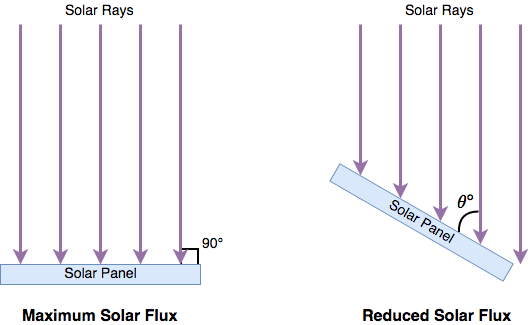
Traditionally solar installations are installed in fixed positions directed toward the location where the sun is most intense and most present during the day. This position changes depending on the location of installation. However, sunlight is most efficiently utilized by the panel when it is perpendicularly incident upon the panel surface, meaning that panels reach peak efficiency when they are directly facing the sun. In fact, a panel optimally directed at the solar position throughout the day can produce up to 30% more power than a fixed angle system [1].

Passive Tracking
Passive solar tracking does not require any electricity, motors, gears, or controllers for panel movement. Instead most use a low boiling point compressed gas is used to mechanically control the panel movement. The gas is encapsulated and as the sunlight hits the gas cylinder it selectively experiences a volume and pressure increase in the location where the incoming solar radiation is most intense, providing the most heat. In this manner, the panel can track the solar position without requiring operational energy.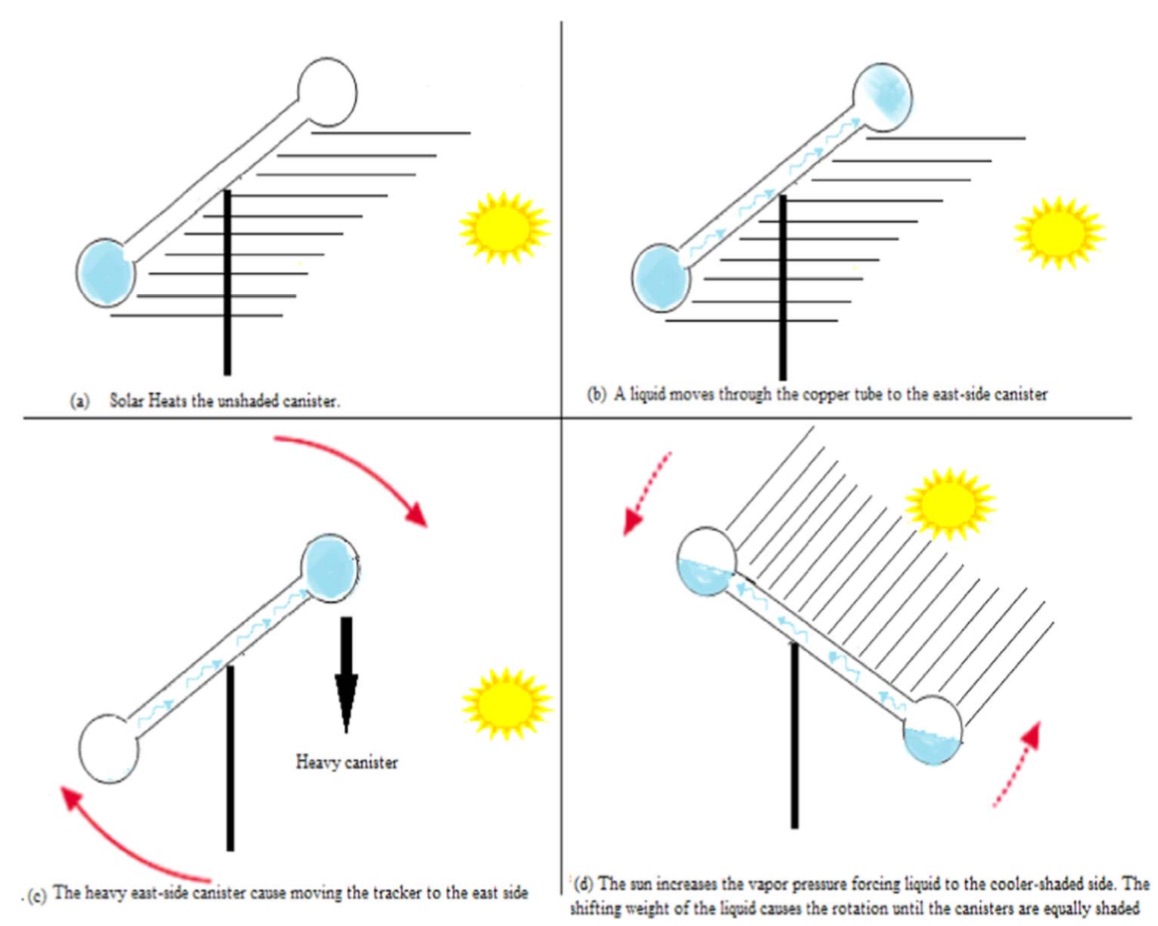
Source: Al-Rousan, N & Ashidi Mat Isa, Nor & Mat Desa, Mohd Khairunaz. (2017). Advances in solar photovoltaic tracking systems: A review. 10.1016/j.rser.2017.09.077.
Active tracking usually includes the use of a single axis or bi-axial slewing drive which allows the panel to orient toward the sun using a set of motors. These motors are powered by the produced solar energy. This type of tracking, unlike passive tracking, requires a guidance system to direct the location of the panel and control the motors.
Source: Al-Rousan, N & Ashidi Mat Isa, Nor & Mat Desa, Mohd Khairunaz. (2017). Advances in solar photovoltaic tracking systems: A review. 10.1016/j.rser.2017.09.077.
Passive solar tracking does not require any electricity, motors, gears, or controllers for panel movement. Instead most use a low boiling point compressed gas is used to mechanically control the panel movement. The gas is encapsulated and as the sunlight hits the gas cylinder it selectively experiences a volume and pressure increase in the location where the incoming solar radiation is most intense, providing the most heat. In this manner, the panel can track the solar position without requiring operational energy.

Source: Al-Rousan, N & Ashidi Mat Isa, Nor & Mat Desa, Mohd Khairunaz. (2017). Advances in solar photovoltaic tracking systems: A review. 10.1016/j.rser.2017.09.077.
Active tracking usually includes the use of a single axis or bi-axial slewing drive which allows the panel to orient toward the sun using a set of motors. These motors are powered by the produced solar energy. This type of tracking, unlike passive tracking, requires a guidance system to direct the location of the panel and control the motors.

Source: Al-Rousan, N & Ashidi Mat Isa, Nor & Mat Desa, Mohd Khairunaz. (2017). Advances in solar photovoltaic tracking systems: A review. 10.1016/j.rser.2017.09.077.
While the concept of solar tracking is not new, solar tracking systems have not been widely implemented across industry as they have not yet proven to be cost effective.